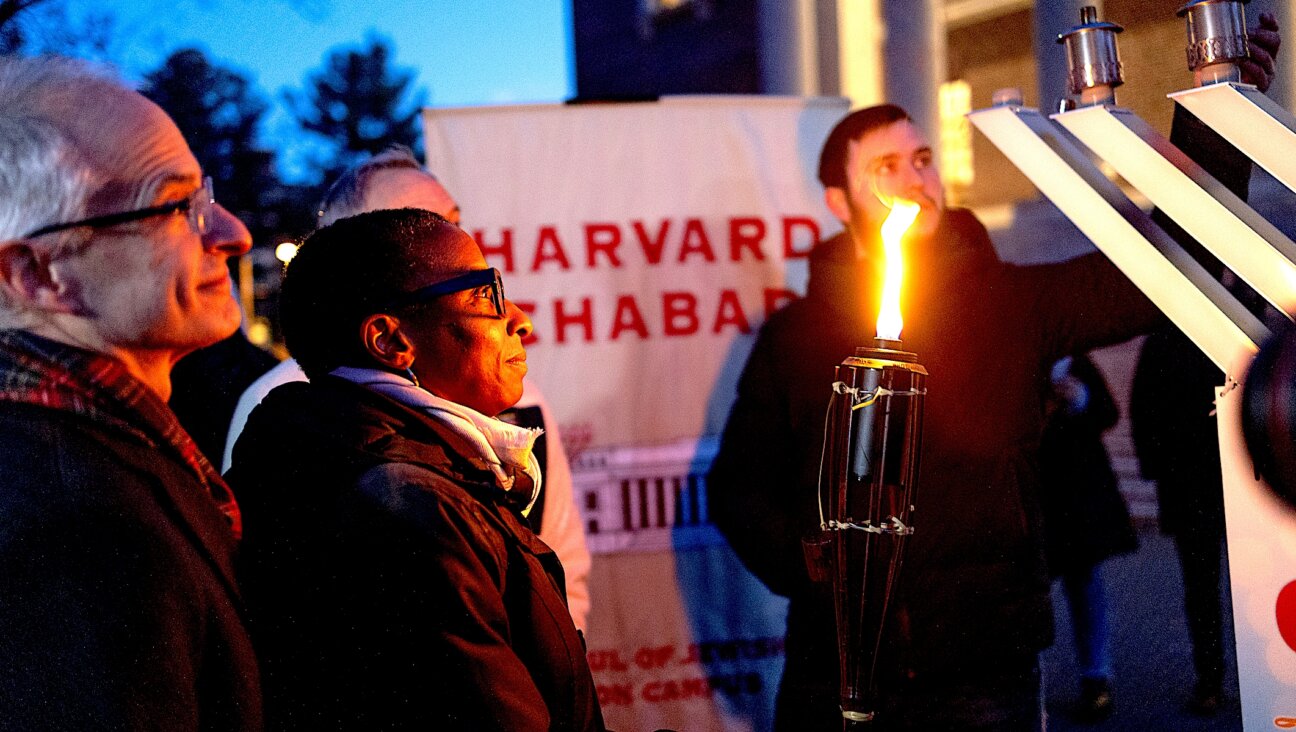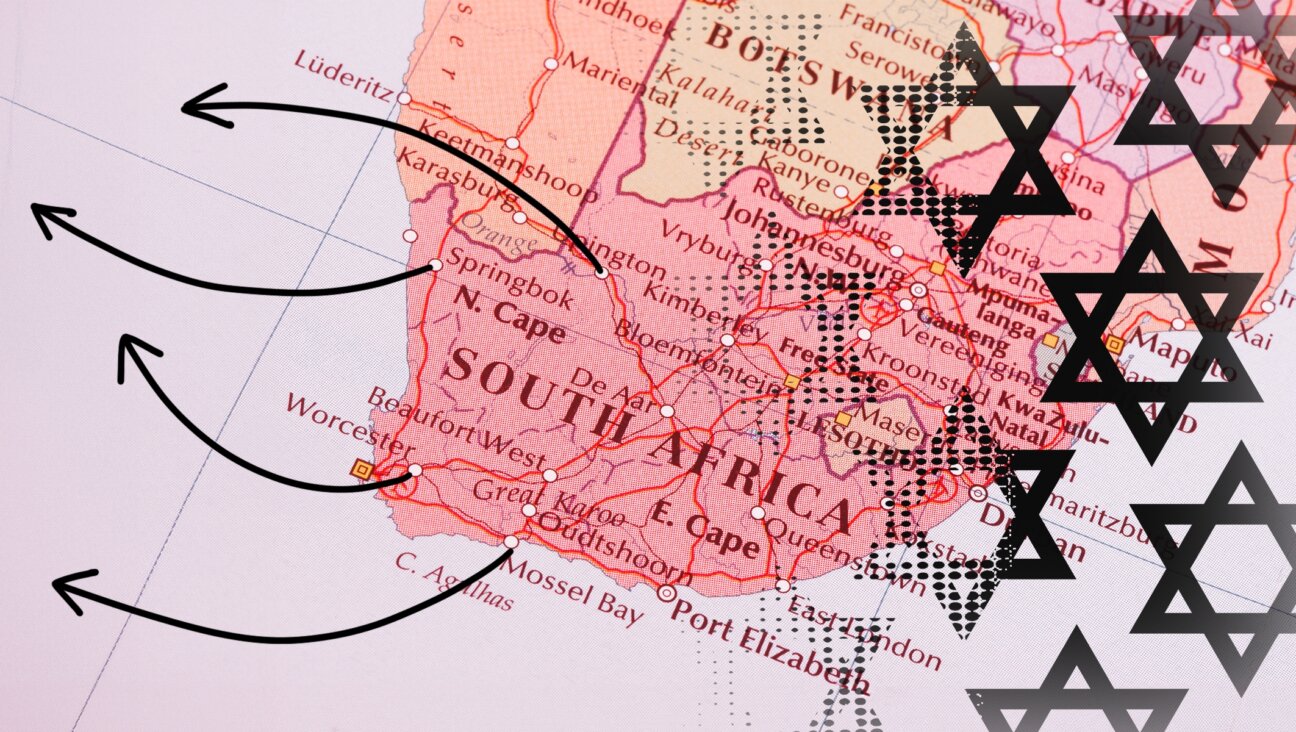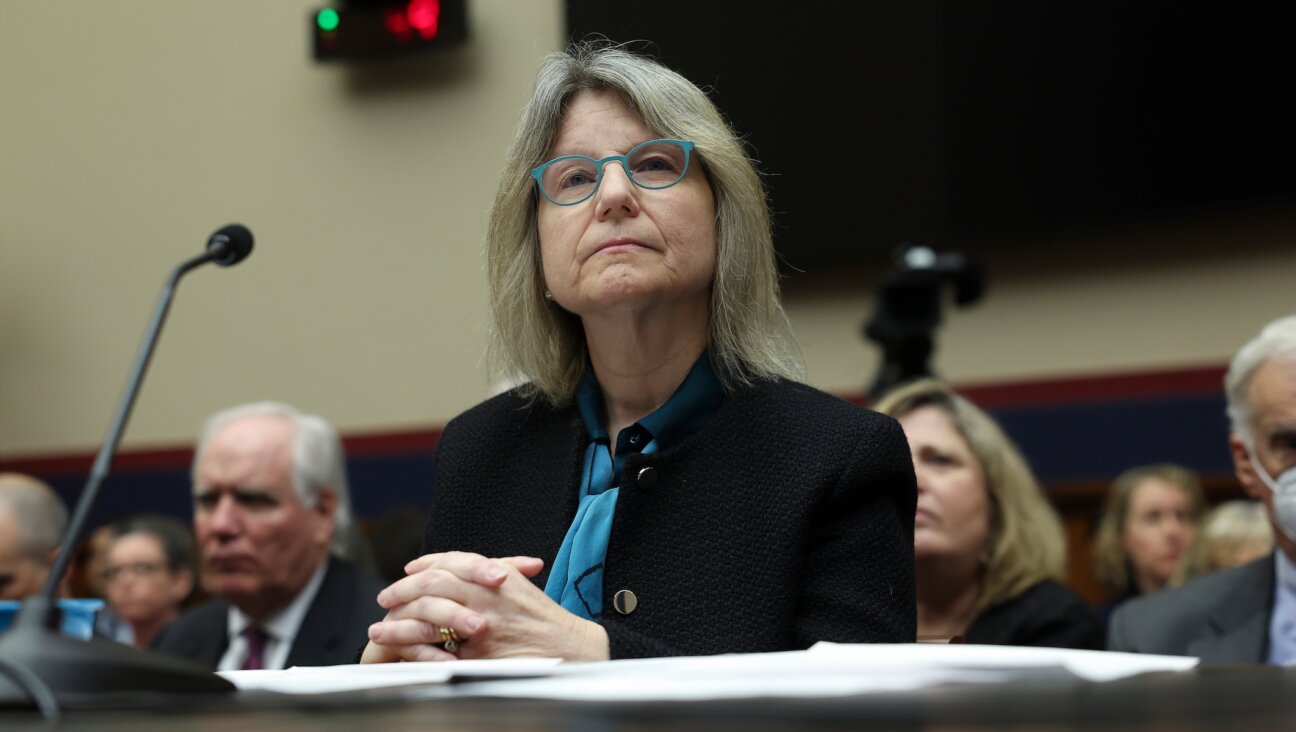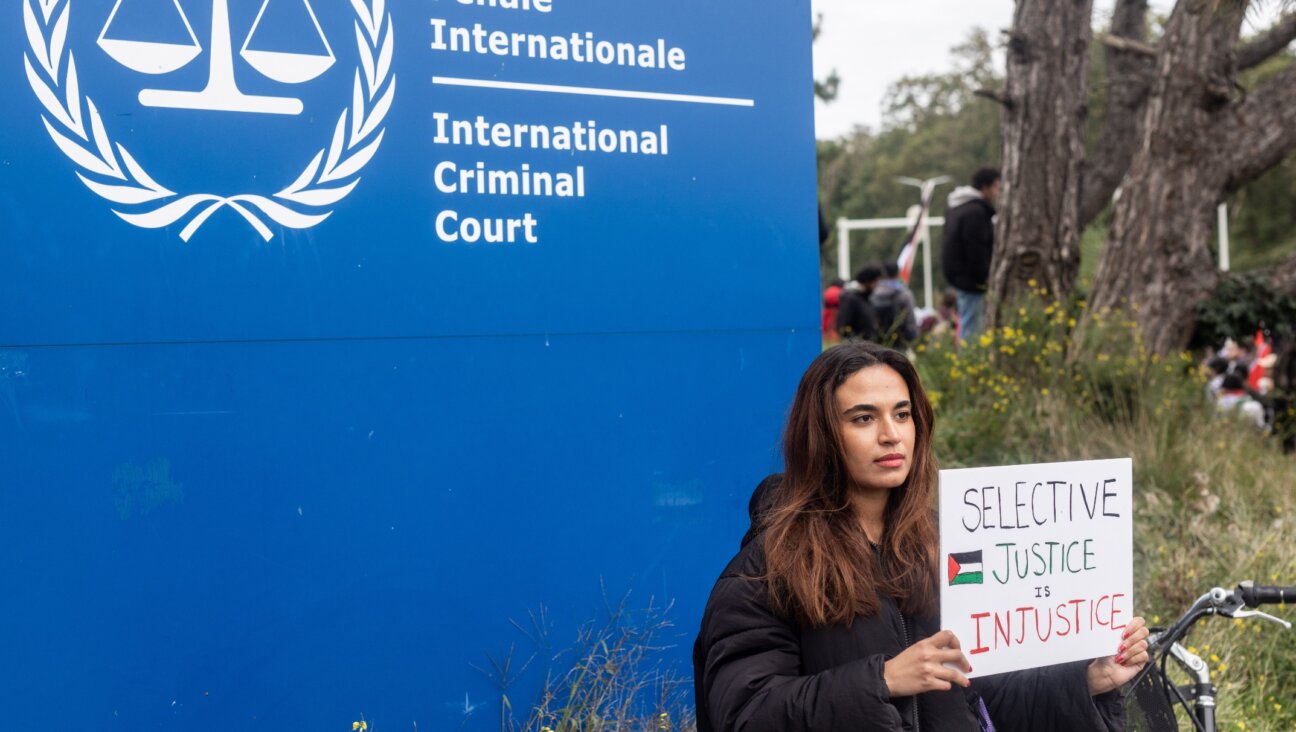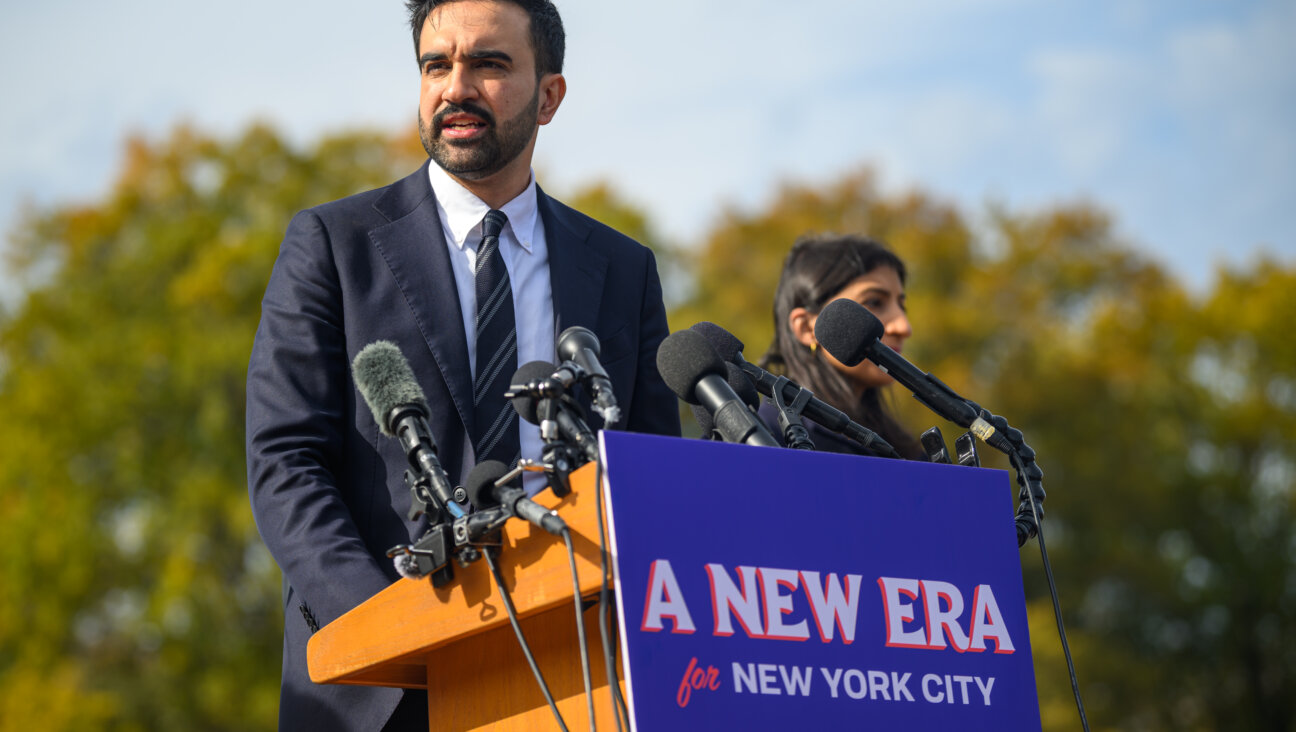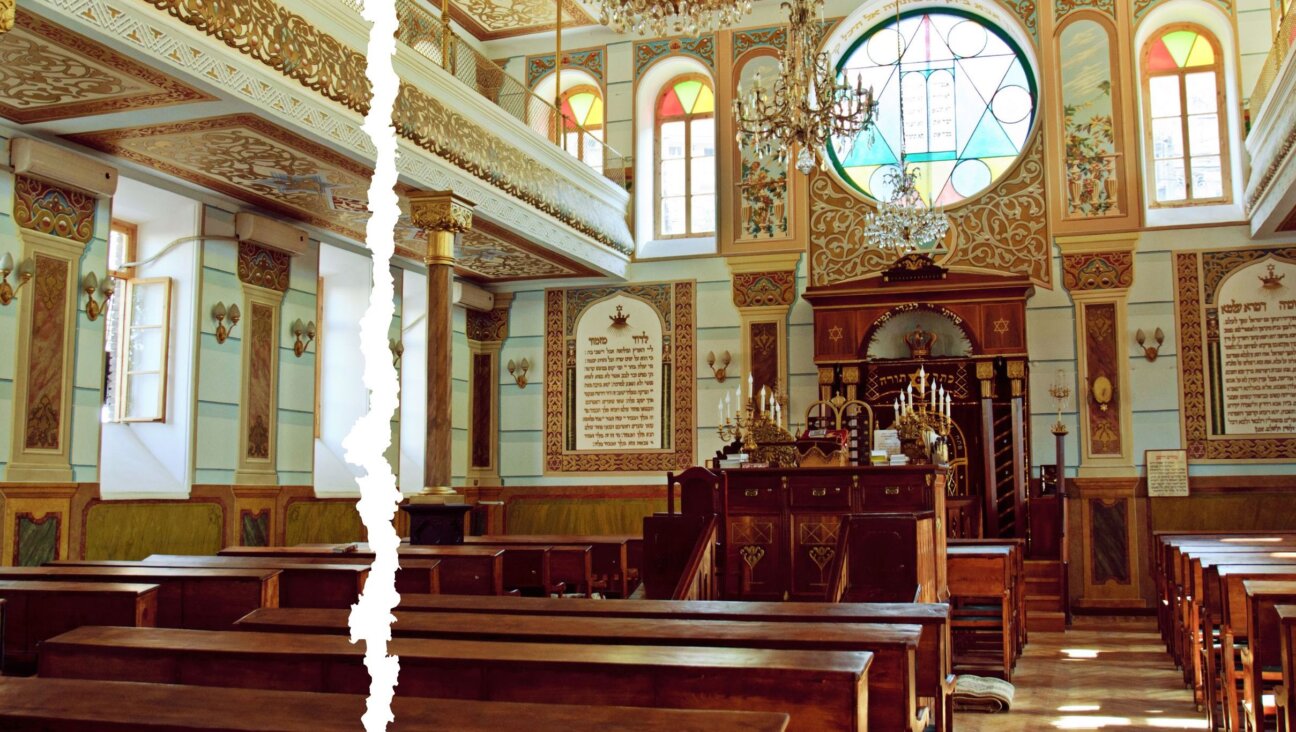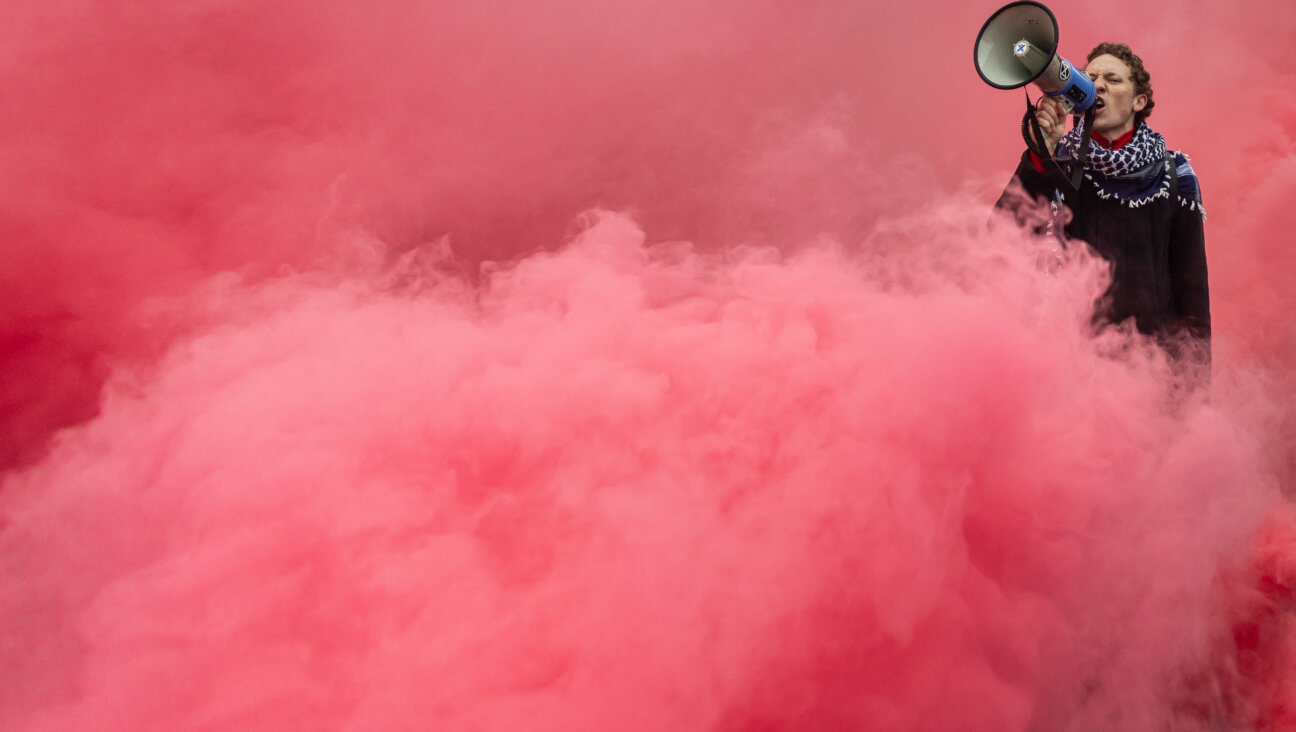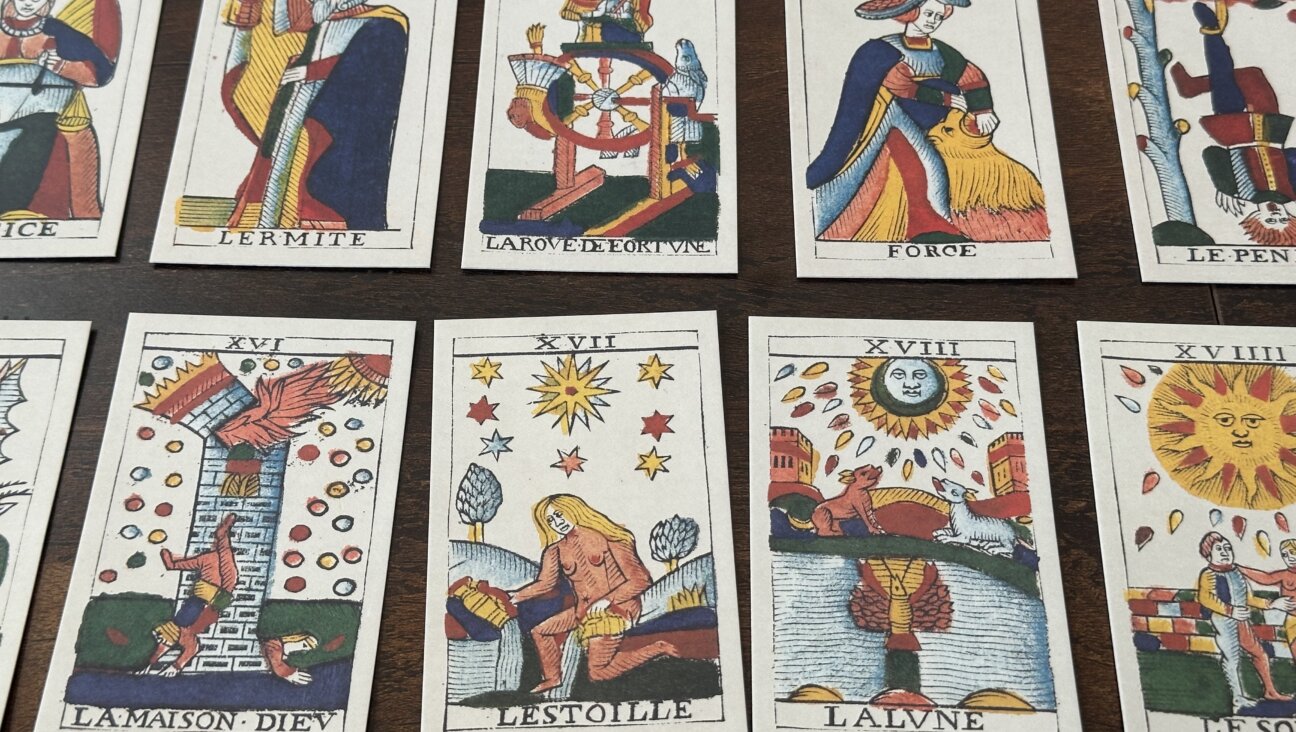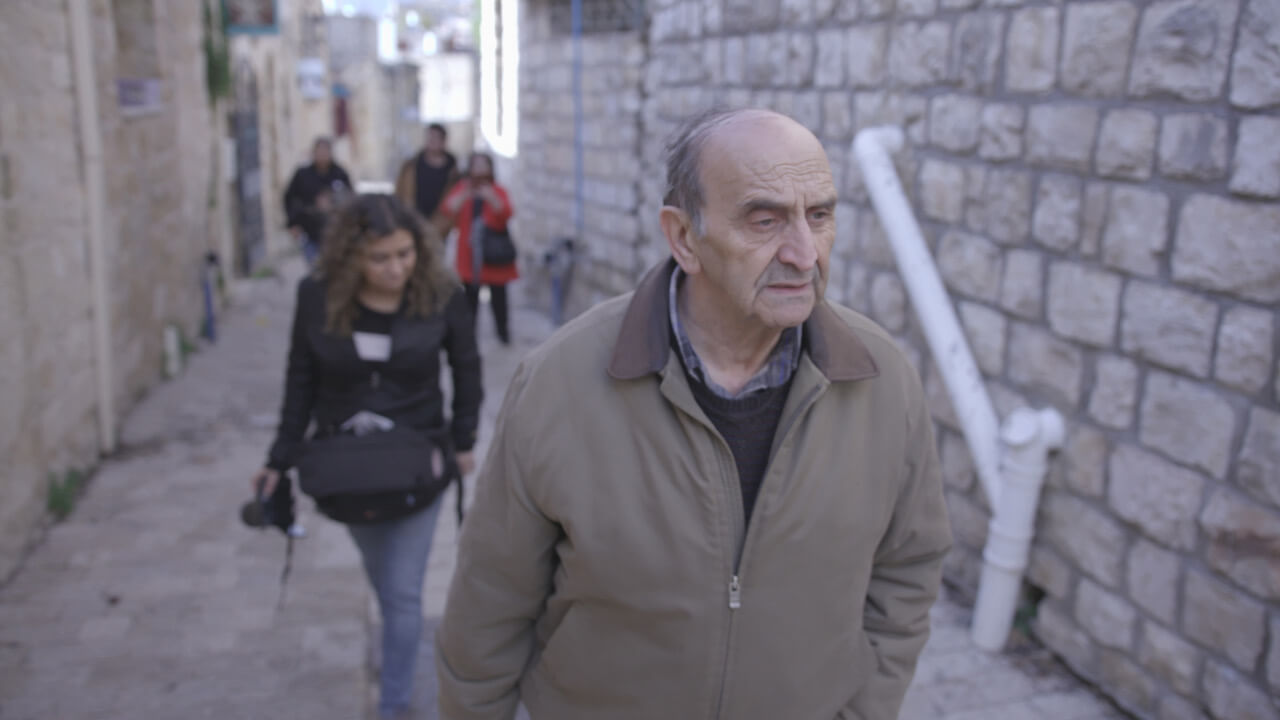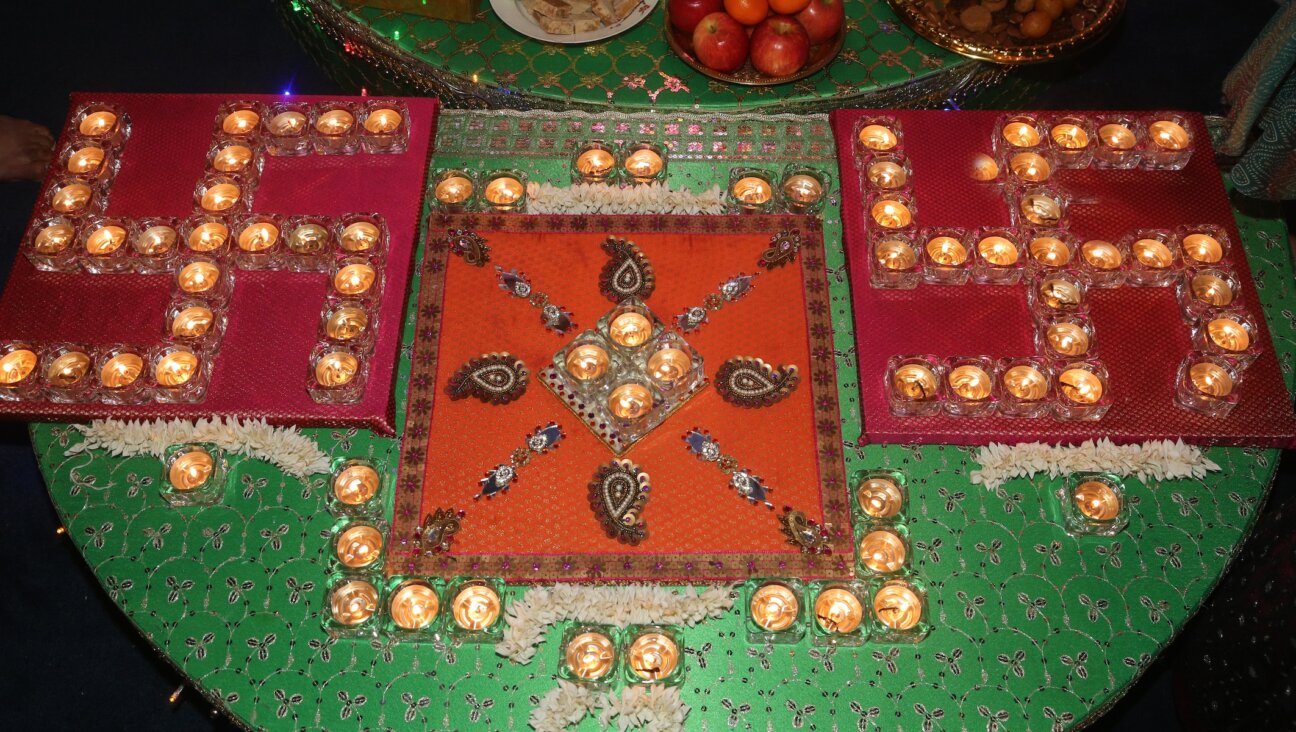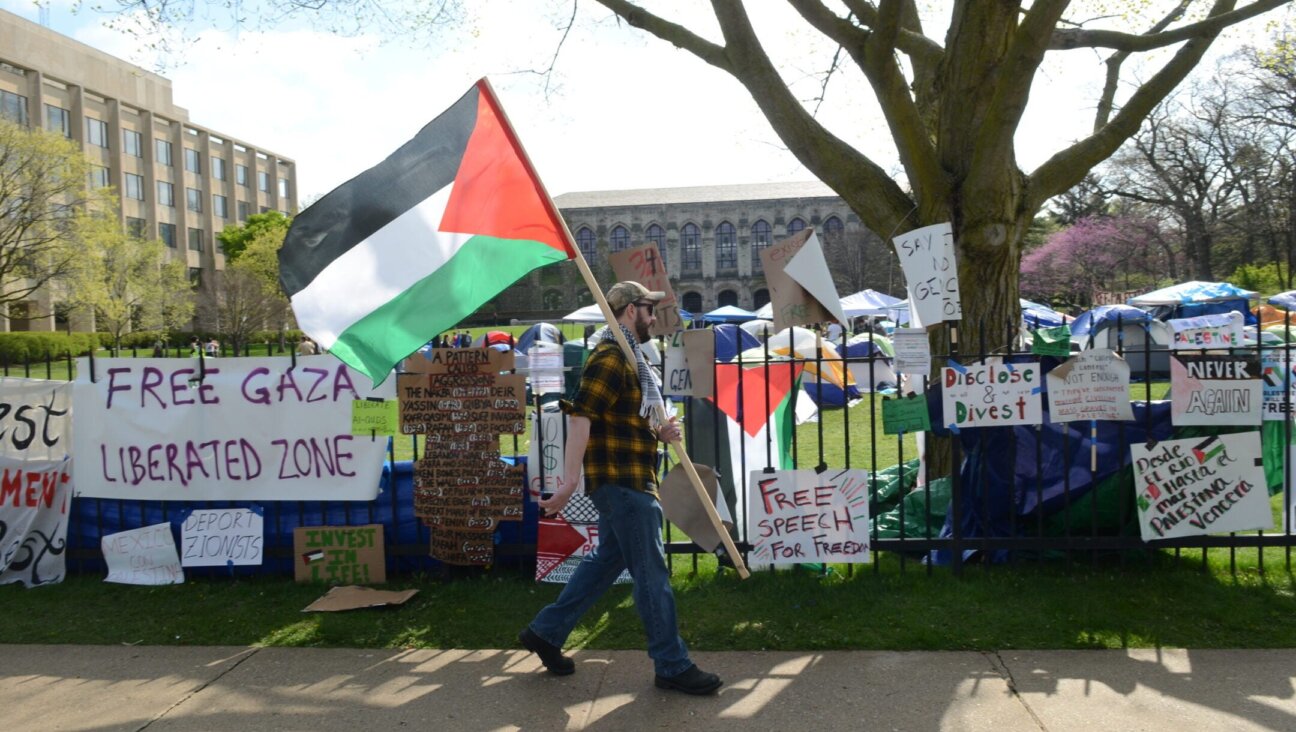A Jewish Journalist’s Exclusive Look Inside Iran

View of Ayatollah Khomeini’s tomb, Teheran. Image by Larry Cohler-Esses
Pasagardae, Iran —— In the heart of Fars Province on Iran’s high desert plateau in the South, a stark and bare large limestone tomb juts out of the landscape. It’s in the middle of nowhere. But the understated burial place of Cyrus the Great still draws Iranians on pilgrimage.
Mohammad Parvi, a retired sugarcane factory worker, told me he was there with his family on this pitilessly hot and shadeless July afternoon because he wished to pay homage to “our ancestor, the grandfather of all Iranians.”
Cyrus, way back in the sixth century BCE, he averred, “exported human rights to the other nations. He denounced slavery. He made people respect each other.”
Historians reject each of these claims. But many Iranians believe them, thanks in part to a relentless propaganda campaign conducted by the shah of Iran, Mohammad Reza Pahlavi, to legitimate his own rule as Cyrus’s heir in the early 1970s. And for the shah’s theocratic successors, that can sometimes be a concern.
Soon after Parvi and his family paid their respects to the ancient king, a 38-year-old Iranian expatriate who now lives in America approached Cyrus’s tomb with her own family. Overcome with emotion in the tomb’s presence, she told me that Cyrus had “built an empire on peace and love” in an ancient world filled until then with bestial savagery.
“When I look at Iran today, I feel very heavy because I feel we have failed him,” she said. Reverently, the woman placed a bouquet of yellow flowers on the stone base at the foot of the tomb — whereupon the guards brusquely informed her this was not allowed, and hauled off her sister and her sister’s husband for questioning.
As it happens, the ban against flowers on the tomb was understandable, since their presence can attract insects capable of harming the limestone. But the woman, who requested I not use her name because her family still lives in Iran, related that what also caught the attention of the Revolutionary Guard whose members questioned her relatives was her raw display of emotion.
“They thought I might be associated with some kind of political movement,” she said.
Thirty-six years after a vast and diverse movement of Iranians coalesced around the elderly Grand Ayatollah Ruhollah Khomeini to overthrow the shah’s corrupt rule, the unique, theocratically controlled electoral polity he established sits today on the precipice of a huge change. After decades of isolation, many (though not all) of the international sanctions imposed against it are slated to be dropped in exchange for Shi’ite Tehran submitting to a nuclear inspection regime of unprecedented scope. American sanctions will also be lifted if Congress does not veto the deal negotiated by the United States and the five world powers. Iran consequently stands to reap a huge windfall of unfrozen assets, foreign investments and ramped-up trade that will eventually bring in hundreds of billions of dollars.
At the same time, this opening up threatens to bring with it — the world.
READ: WHY WE SENT A REPORTER TO IRAN
That afternoon at Cyrus’s tomb, the Iranian expatriate, a gemologist from New York City’s Upper East Side, with her suspect reverence for ancient Persia’s founder, was just an early sample of the flood of people that will come.
And so was I. My visit, coming after two years of seeking a journalist’s visa to report from Iran, represented something special: I was the first journalist from a Jewish, pro-Israel (if not always pro-Israel government) publication to be granted a journalist’s visa since the 1979 Revolution. Whether this was a reflection of increased openness by the government I cannot say. My visa came only after a former representative of Iran’s Jewish community in the country’s parliament wrote a letter on my behalf.
But for me, my visit was special for another reason. I had lived in Iran for almost two years in the late 1970s, just before the revolution. There, shortly after having finished college, I taught English as a second language in Shiraz and Isfahan, two of the country’s most beautiful cities. In many ways, that time in Iran, coming soon after my academic education, constituted my real education.
Then, the discontent was eruptive and in the open. Student strikes in the major universities went on for weeks. The rampant corruption under the shah constantly stared Iranians, and visitors, in the face. The fear of intelligence agents was thick in the air. Once, in a restaurant, when we were watching the shah give a speech on TV, my comment that he looked kind of thin earned me a swift kick under the table from a frightened friend.
At the same time, there were ineffable moments of beauty that are hard to imagine today. Every Wednesday night, one of my housemates, a young American woman studying Sufism with the Nematollahi order centered in Shiraz, invited a poet to our spacious house in a Jewish neighborhood of that city. The house, like most Iranian houses, was built around a large enclosed courtyard open to the sky, with trees and a small cooling pool of water at the center. There, the poet, who freelanced as an announcer on National Iranian Radio and Television, would spread a Persian carpet on the ground, where we all sat down, cross-legged, under a lemon tree while the stars twinkled above, and he would read for hours from the Masnavi, a 13th-century collection of poetry by the Sufi mystic Rumi.
I thought to myself then, “I’m not in Chicago anymore” and clicked my heels.

Burial place of Cyrus the Great in Fars Province, Iran. Image by Larry Cohler-Esses
But where was I today? The Nematollahi sect that had been the object of my housemate’s devotion, like most Sufi orders, has faced harsh persecution in contemporary Iran. So do the Baha’i, seen as followers of a heretical offshoot of Islam. According to Human Rights Watch, even Sunni Muslims face discrimination.
The Iranian Jewish community, whose members are today free to stay in the country or emigrate, currently numbers anywhere from 9,000 to 20,000, depending on whom you talk to, and down from 80,000 to 100,000 before the revolution. These Jews — along with Christians and Zoroastrians — are tolerated and protected under Iranian law, but subject to a number of discriminatory laws and practices that limit their opportunities for work in senior government posts and in other ways. But they do not limit their opportunities in business.
The Jews, who felt free to complain to me openly about these areas of discrimination, as they do to the government, are basically well-protected second-class citizens — a broadly prosperous, largely middle-class community whose members have no hesitation about walking down the streets of Tehran wearing yarmulkes.
But there is a catch. The government makes a rigid distinction between hostility to “the Zionist entity” and respect for followers of Judaism. As for that Zionist entity where some 6 million Jews live, former president Mahmoud Ahmadinejad’s avowal that Israel “must vanish from the page of time” or, as it has been inaccurately translated, “wiped off the map” (either way, an unequivocal threat) continues to be the policy of the Islamic Republic as articulated in varied semantic formulations by its supreme leader, Ali Khamenei, a figure whose authority trumps that of Iran’s elected government.
The Islamic Republic’s decision to grant me a visa just as Congress is debating the nuclear agreement could have been a well-timed move to influence that debate. The New York Times announced it thought so in its news brief August 6 about the decision. But if so, the signals to that effect were mixed.
I first began trying to get a visa almost two years ago, at the suggestion of a press officer in Iran’s United Nations Mission when I asked him for an interview with Hassan Rouhani, who had just been elected Iran’s new president and was making his first visit to address the General Assembly. But the press officer suggested I try instead to visit Iran. Nevertheless, I had to navigate bureaucracy and apply three more times before my visa was approved.
Though I had to work with a government fixer and translator, I decided which people I wanted to interview and what I would ask them. Far from the stereotype of a fascist Islamic state, I found a dynamic push-and-pull between a theocratic government and its often reluctant and resisting people.
***
During the course of my conversations with several senior ayatollahs and prominent political and government officials, it became clear that there is high-placed dissent to the official line against Israel. No one had anything warm to say about the Jewish state. But pressed as to whether it was Israel’s policies or its very existence to which they objected, several were adamant: It’s Israel’s policies. Others, notwithstanding their ideological objection to a Jewish state, made it clear they would accept a two-state solution to Israel’s conflict with the Palestinians if the Palestinians were to negotiate one and approve it in a referendum.
Ordinary Iranians with whom I spoke have no interest at all in attacking Israel; their concern is with their own sense of isolation and economic struggle. Official government statistics estimate the unemployment in Iran at around 10%. But unofficial sources estimate it as twice that — and this in a context in which only 36% of the population participates in the workforce. An estimated 150,000 Iranians with college educations leave the country yearly.
But among ordinary Iranians the sense that something is now opening up in the country is pervasive. It began with the election of the reformist presidential candidate Rouhani in 2013, long before the recently negotiated nuclear agreement introduced the prospect of crippling sanctions being lifted. And the impact of this mood on people’s willingness to speak out is clear.

Image by Larry Cohler-Esses
In Iran today, freedom of the press remains a dream. But freedom of tongue has been set loose. I was repeatedly struck by the willingness of Iranians to offer sharp, even withering criticisms of their government on the record, and their readiness sometimes even to be filmed doing so.
“The people of Iran want in some way to show the world that what’s going on in the last years is not the will of the Iranian people but of the Iranian government,” Nader Qaderi told me as I filmed him with my phone outside his butcher shop in North Tehran’s Tajrish Market. A small crowd looked on as we talked. “We have no hostility against Israel,” he stressed.
Asked about prospects for the international nuclear agreement, which is coming under angry fire in Iran no less than in the United States, Qaderi told me: “I think it will be implemented. But there will be no improvement for the Iranian people. Our main concern now is freedom! I think what we need most of all now is political intelligence. People have no clear idea of what they want. This is the real struggle.”
I was surprised to find Qaderi even willing to criticize the Islamic Republic’s founder, Khomeini, for having uselessly squandered the lives of hundreds of thousands of his countrymen in the Iran-Iraq War. The war is regarded as a holy struggle, or jihad, in Iran, and its Iranian victims as sacred martyrs. After all, it followed Iraqi leader Saddam Hussein’s unprovoked invasion of Iran in 1980. By 1982, Iranian forces had beaten back the invaders to their side of the international border. But the conflict continued for six more years, because of Khomeini’s determination to use it as a vehicle for mobilizing the masses around his revolutionary regime. In the end, Khomeini accepted a cease-fire on the same international border at which the war had started — a decision he compared to “drinking poison.”
“Khomeini didn’t accept the cease-fire” when it was first proposed by the U.N., Qaderi noted. “As a result, the war went on for eight [sic] more years. He made a mistake.”
Today, he added, “Khamenei is now making mistakes. He calls our position [toward the agreement] ‘heroic flexibility.’ We resist and we are flexible. But against what are we resisting?”
In Shiraz, in south-central Iran, Hassan Sha’aeri, a locksmith who appeared to be in his 60s with a shop on Zand Street, the town’s main thoroughfare, told me: “Generally speaking, people are in favor of the agreement. But I personally don’t think it will make any special change in the lives of people. The power holders will not allow it to benefit the people.”
Asked if he thought the agreement could open up Iran to the world and usher in broader cultural changes, Sha’aeri, a man old enough to recall earlier days, said: “Before the revolution we had all kinds of arts and culture. Of course, we had some limitations. But now there are many more problems in terms of things like the economy and political prisoners.”
“We have no enmity toward any countries,” Sha’aeri said in regard to Israel. Besides, he added as a small group of men in his shop listened in, “I think it’s impossible to destroy Israel.” If Iran were to attack the Jewish state, he said, “there will be huge destruction in return. It cannot happen. Every action has a reaction. Israel will not stay motionless, and the United States will not stay motionless.”
As I left Sha’aeri’s shop, the dignified locksmith said he wanted me to know that separately from everything else, “I’m happy people like you come here and seek to make friends. If people like you come here, I will learn from them.”

Larry Cohler-Esses with Mohammad Parvi and his family at Cyrus' tomb.
***
One thing is for sure: Iran’s rulers are aware of the two-edged nature of the opening to the world that the lifting of sanctions would bring — and they appear to be divided over it.
When Rouhani came to the United Nations, soon after his surprise election victory he made it clear that the nuclear agreement he sought was not just about unfreezing financial sanctions in exchange for nuclear transparency.
“Within a very short period of time there will be a settlement of the nuclear issue,” he told the New York press corps then. “And step-by-step [this will] pave the way for Iran’s better relations with the West, including the expansion of economic ties, the expansion of cultural ties and the expansion of relations between the Western nations and Iran.”
But under Iran’s hybrid theocratic electoral structure, it is Khamenei, not the elected president of the country, who has the last word, and he seems to be on guard already against what his security services regard as the dangers of a “velvet revolution.”
“We have repeatedly said we do not negotiate with the U.S. on regional or international affairs, not even on bilateral issues,” he said July 18, shortly after the nuclear agreement was signed. “There are some exceptions, like the nuclear program that we negotiated with Americans to serve our interests. U.S. policies in the region are diametrically opposed with Iran’s policies.”
Twelve years after President George W. Bush bet that the exercise of American hard power could introduce democracy to Iraq at the point of a gun and spread its virtues regionwide, his successor appears to have premised his nuclear agreement with Iraq’s neighbor on a much different bet: a wager, essentially, on the long-term efficacy of soft power.
It’s a bet that has some precedents to support it — among them, President Nixon’s move to détente and trade with the Soviet Union, the nuclear power with intercontinental ballistic missiles whose leader during the 1960s, Nikita Khrushchev, famously threatened the West, Ahmadinejad-style, saying, “We will bury you!”
Twenty years after Nixon’s initiative, an educated populace increasingly aware of the West’s freedoms and its own isolation brought down its own Communist government.
While Obama has never said so directly, he seems to believe that Iran is capable of changing during the 15 years of the nuclear agreement. Israeli Prime Minister Benjamin Netanyahu scoffs at this notion.
I cannot judge this question. More important, I don’t think that those for or against the agreement have any reliable way of judging this, either. In 1981, how many people — whether hawks or doves — predicted that the Soviet Union would be finished a decade later?
Iran, though, is different from the Soviet Union in one key respect: In most countries, there is a social contract that governs relations between the government of a state and its people. But in Iran there are three players: the people, the government and, for lack of a better term, the Deep State, which in the person of the supreme leader claims to act on God’s behalf to ensure that neither of the other two parties strays beyond God’s boundaries as defined in Islam.
This makes things much more complicated.
Since the 1979 Revolution, most of the darkest chapters in Iran’s national narrative have stemmed from the actions of this Deep State. In 1988 it was the Deep State that executed an estimated 5,000 to 30,000 citizens deemed leftists, counter-revolutionaries or heretics; the exact number isn’t known, because the executions were done in secret.
Much more recently, it was on Khamenei’s order that security forces moved to ruthlessly suppress mass protests that erupted nationwide in 2009 after election authorities announced that Ahmadinejad, a resolute conservative hard-liner, had been re-elected by a large margin in his contest against two popular liberal reformists despite strong indications of fraud.

Inside Ayatollah Khomeini's tomb. Image by Larry Cohler-Esses
And it is the Deep State, under Khamenei’s authority over successive governments, that has maintained Iran’s unwavering but widely unpopular support for various surrogate forces abroad — from Shia militias in Iraq to Hezbollah in Lebanon, where the group’s huge arsenal of rockets constitutes a threat on Israel’s northern border.
For all that, even the Deep State is not immune to popular pressures. Khamenei seemed to take into account the huge domestic and international costs of suppressing the 2009 election protests — and allowed Rouhani to take office when he won in 2012.
Khamenei’s awareness of the popular support Rouhani had for his central election campaign promise — to negotiate an end to Iran’s economic and political isolation — also moved him to back warily the lengthy nuclear negotiations, though Khamenei has yet to take a stand on the accord itself.
I thought of these pressures as I passed through a security checkpoint in Tehran’s domestic air terminal and showed my U.S. passport to a guard who told me, “More of you should come!” It occurred to me when I entered the vast, monumental burial site of Khomeini and, on being told I was an American Jew, the Revolutionary Guard on duty waved me through with a huge grin, allowing me to enter with my camera, against the rules. One of his comrades posed happily for a photo with me.
At the Espinas Hotel in Tehran, where I stayed, the potential of this Nixonian vision of change hit me smack in the face when the young waiter in one of the hotel’s restaurants asked where I was from. “America,” I told him, only to see him react with a look of pain as I continued to dine on kookoo sabzi, a delectable Persian spinach frittata with fresh herbs. Feeling guilty somehow, I put aside my plate and asked him what was wrong.
“They think we’re bad people,” he said in halting English, referring to the West. “They think we’re terrorists. Why?”
Conscious of his limited English, I replied with shorthand: “Nuclear issues. Politics between the United States and Iran. Iran and Israel, and Hezbollah. Iran and Israel and Hamas.”
“It’s our government, not the people,” he said slowly. “I think it was better before.” By which he meant the era of the shah, a man whose reign ended around the time he was born.
Underneath the superstructure of Iran’s theocracy, a panoply of activists, thinkers and ordinary citizens are struggling to understand the world around them, from which they have been largely isolated — partly by international sanctions and, more importantly, by a government monopoly over information that seems to work, however imperfectly. Television, where most Iranians get their news, is under the control of an office that answers only to the supreme leader. And while satellite dishes abound in Tehran’s more affluent neighborhoods, the government does all it can to block them. Periodically, it also cracks down on the illegal dishes, imposing fines and confiscating the equipment.
The Internet, another potential information source, is stringently censored. (Our website, forward.com, is one of many blocked.) While tech-savvy young people devise workarounds, the effort is time consuming and only for the most motivated. This leads to a paradox: In contrast to Americans, who are often uninformed, Iranians are very much up on the news, but often profoundly misinformed, especially about the outside world. But they are curious.
“What do Americans think of the Revolutionary Guard?” asked one of the Revolutionary Guards stationed at the tomb of Khomeini during the first of my two visits to this most political of mausoleums.
When I told him that ordinary Americans who had heard about them were probably afraid of them, he expressed bafflement.
“America is a rich country with advanced technology, a huge army, enormous size and a large population,” he said. “Iran is a small country with a small army, much less developed technology and much poorer. Why would Americans be afraid?”
I spoke of the enduring anger stoked by revolutionary Iran’s illegal takeover of the U.S. Embassy in 1979 and its holding of the 52 American hostages for 444 days there. “That was Iran’s big mistake,” I said. “Maybe America’s big mistake came earlier, in 1953,” I added, referring to the CIA’s role then in helping to throw out Iran’s democratically elected prime minister and restore the shah to his throne. But most Americans, I told him, are completely unaware of this. “So now, maybe we’re each stuck with each other’s memory of each other’s mistakes,” I said.
Initially, stern and severe, Javad, who, conscious of being on duty, gave me just his first name, melted over the course of an hour-long conversation. He peppered me with questions. “The problem with America is the government, not the people,” he said toward the end. But when I brought up Israel, he said, “Israel, the problem is both the government and the people.”
I asked why this was different.

Image by Larry Cohler-Esses
“In America,” he said, “the people at least protest against the government. But never in Israel.”
Javad was unaware of the massive protests during the Lebanon War in 1982 after the massacre of Palestinian refugees by Phalangists, for which then-defense minister Ariel Sharon was ultimately held accountable. In fact, he erroneously believed that Sharon stayed in office then, until his stroke. This was the power of the government’s control of media and information.
I have no doubt that he learned, via Iranian media, about the murder of a Palestinian toddler and his father by suspected and as-yet-unknown Israeli Jews who burned him to death in the occupied West Bank one week after our conversation. I am much less certain he heard about the protests that took place against this atrocity across Israel. Whether Javad learned about the stabbings of gay and lesbian Jews by an ultra-Orthodox extremist the same day could go either way, given Iran’s homophobia.
***
Curiously enough, it was among some of Iran’s most senior ayatollahs that I found indications of serious debate — or at least divergences from Khamenei’s official position.
Ayatollah Mostafa Mohaghegh Damad, a senior cleric with family ties to some of Iran’s most prominent political figures, singled out Israel’s policies, not its existence, as his problem with the Jewish state, citing purported violations of international law rather than religious objections.
“What I have against Israel is its policies against humanitarian law,” he told me during a long interview at his home in Tehran. “That’s it. Whenever it’s about international law, I stand up and raise my voice against that violation. And many people think like me. It’s their violations of the Geneva conventions.”
Damad, who has been an ayatollah since 1970, is the son of a prominent grand ayatollah and the brother of another ayatollah close to Khamenei. He is also related, via his wife and through his children’s marriages, to several powerful political families, including to Khomeini.
Meanwhile, in the conservative holy city of Qom, I spoke with two of Iran’s handful of living grand ayatollahs. Some 100 miles south of Tehran, Qom is 20 miles southwest of the village Fordow, where Iran has built a large underground facility to enrich uranium. The facility was built into a mountain in a clear effort to protect it from a possible bombing campaign. But Qom, site of the shrine of Fatema Mae’sume, the revered sister of Shia Islam’s eighth imam, is the largest center for Shi’a scholarship in the world — a city of pilgrimage, of mosques and mullahs, and of major ayatollahs who site their own schools and centers there.
One of these is Grand Ayatollah Abdolkarim Mousavi Ardebili, 89, a close friend, confidant and longtime supporter of Khomeini, who appointed Ardebili as Iran’s chief justice in 1981. It was a post in which he served until 1989, spanning the years of the Iran-Iraq War and the ruthless justice of the post-revolutionary period.
Yet for all that, Ardebili is today a supporter of the reformist movement that helped bring Rouhani to power. Still, during an audience in his home, Ardebili said little that would indicate a moderating stance on Israel from a reformist champion.
“Islam’s point of view regarding the Jewish nation is very high,” he said, speaking through his son, Seyed Masoud Moosavi Karimi, a noted academic, who translated. “We learn from the Quran that Jews are as respected as Muslims.”
But, responding specifically to my question about Israel and whether it was Israel’s policies or its actual existence to which he objected, Ardebili said, “We believe that the State of Israel must be changed, corrected and improved. And if that is not possible, and if the nature of the state does not allow for improvement, then the state must be destroyed.”
The only way to achieve peace, he explained, was for the Israelis “to stop their cruelty against Palestinians.” Israel, he said, “kills children and proudly defends killing them.”
I asked Ardebili in what instance Israel had proudly defended killing children. Karimi quickly explained that his father meant that Israel “defends the policies behind this killing.”
I asked if Ardebili would support a two-state solution to the Israel-Palestinian conflict if one were reached.
His son wouldn’t let him answer this sensitive question. “I’m afraid my father is not familiar with the idea of two-state solution,” Karimi said. “This is an idea much discussed in the West, but not much here.”
Grand Ayatollah Yousef Saanei lives less than a mile from Ardebili, in a modest, anonymous-looking house in a small alleyway off a busy thoroughfare — but the distance between these two ayatollahs on the topic of Israel could not be greater.
Like Ardebili, Saanei, who was one of Khomeini’s prize students, is considered a reformist — in fact, he is often referred to as “the spiritual father” of Iran’s Green Movement. When waves of protest swept Iran in 2009, after election authorities declared that Ahmadinejad had won re-election overwhelmingly despite widespread cries of fraud, Saanei was the protesters’ great defender. Khamenei called for a halt to the protests, and when they continued, the Revolutionary Guard and paramilitary groups known as the Basij ruthlessly repressed them. Saanei loudly denounced this repression. He condemned the resulting deaths of some 36 to 72 people (estimates from each side of the conflict). He also condemned the reported rapes in jail of some of those who were imprisoned. Later, unidentified vigilantes vandalized his home.
On entering Saanei’s receiving room, I discovered quickly that there was something he wanted to talk about much more than he did Israel: his disappointment with the nuclear agreement.

Grand Ayatollah Yousef Saanei, considered a reformer by many in Iran. Image by Courtesy of Larry Cohler-Esses
“These negotiations are only about nuclear issues and sanctions,” he complained to me through my translator. “They don’t relate at all to human rights! Basically, the negotiations were not about humanitarian beliefs or spiritual matters. It’s just about money.”
Saanei, who is 78, was wearing a white turban and a black cloak. He looked at me in my chair off to the side through tired, slightly bemused rheumy eyes. Since everyone involved knew from the beginning that there had to be an agreement at the end, he asked me, why did the international negotiators not insist on including other crucial issues?
I asked him what other issues, specifically.
He declared again: “Before anything else, human rights. Freedom of speech and writing. Freedom of thought. Encouraging people to develop their creativity, instead of this huge investment on military and other facilities.”
Benjamin Netanyahu, I told him, had some comparable criticisms about issues left out of the talks, like the actions of Iranian surrogates such as Hezbollah.
Saanei snorted, “If Netanyahu cares about people, why is Israel exiling people and killing them?”
But on the question of whether Israel deserved annihilation, Saanei was adamant. “The idea that Israel should be destroyed is Ahmadinejad’s,” he said. “What Israel should do is change its policies…. It’s impossible to destroy a country.”
Asked if a two-state solution would be acceptable to him, Saanei said simply: “There should be a referendum about this. All human beings should look for mutual humanitarian understandings.”
***
Even in speaking with hard-line political leaders, I found important nuances and differences of opinion when it came to Israel.
Hossein Kanani Moghaddam, a British-trained civil engineer, has been deeply involved in his government’s nuclear development program — as an environmental designer for civilian generators, he stressed. But his enduring claim to wide fame was that he was the Iranian Revolutionary Guard’s top commander during the war against Iraq. A candidate in the 2012 presidential election won by Rouhani, Moghaddam was also, without a doubt, the most fervently anti-Zionist person I met during my seven-day stay in Iran — to the point of anti-Semitism. Moghaddam believes, for example, that “all the world capital, all the investment, the banks, the charities, the economics are under the control of Zionism… 1% of the world is Jewish, but they control all the economy in the world.”
He also believes Jews who have immigrated to Israel from elsewhere should go back to their native land.
Yet when I asked Moghaddam about a two-state solution for Israel and for Palestinians, he replied: “Yes. I’d accept a two-state solution if it were negotiated and put to a referendum, and people in this area chose two separate places. Okay, we will follow them” — so long, he added, as Jerusalem, which he held as holy under Islam, was reserved as a city to be shared by “all the monotheistic religions.”
One clue to Moghaddam’s readiness to accept Israel’s existence under such an agreement despite his stereotypes about Jews may lie in his view of Iran’s own needs and priorities. Given the nation’s long-stymied domestic development imperatives and radically diminished economic position — not to mention the public’s pent-up demand for jobs, goods and government services — Iran must pull back from foreign involvements, Moghaddam believes.
“We have to try to use the money inside,” he said of the billions of dollars in unfrozen assets that would flow into Iran if sanctions were lifted. Iran’s military needs include guarding its borders from deadly neighbors like the Islamic State in Iraq, he said. And he did not mean to abandon Hezbollah or Syria. But he emphasized, “We can support them politically, not militarily.
“We have to reduce the military budget, because in the last few years we have been part of a bad competition with Saudi Arabia and the United States. This destroys the economy of Iran. It’s worse than the sanctions. Even if Saudi Arabia spends $100, we should spend just $1.”

Larry Cohler-Esses with Mohammad Hassan Asafari, chairman of the Iranian Parliament’s National Security and Foreign Policy Committee. Image by Courtesy of Larry Cohler-Esses
Mohammad Hassan Asafari, another famous Revolutionary Guard, who served in Bosnia and Lebanon, is today the chairman of the Iranian Parliament’s National Security and Foreign Policy Committee. During a visit to parliament, when I saw him giving an interview to an Iranian reporter on the balcony overlooking the cavernous main hall as another lawmaker droned on below to a sprinkling of lawmakers, I naturally hustled like any congressional reporter to get in some questions of my own.
Asafari, a trim middle-aged man with a moustache and a politician’s ready smile, has a reputation as a hard-liner. But he did not bat an eyelash when I explained that I was in Iran on behalf of a prominent American Jewish publication.
“We pay much respect to the Jewish people of the world,” he told me. “We have no problem with Jews. The belief that the Jewish community has is the same as ours: one God. The problem is the occupying Zionist regime, which is dominating and displacing the native people.” Pretty much the standard line I heard from everyone.
Asafari told me unequivocally, “I absolutely disagree with a two-state solution.” Like many, he instead advocated the right of return of all Palestinian refugees to their former homes and elections by “all the people living there now — Jew, Muslim and members of other religions” — to decide the country’s future.”
I then put the question to Asafari bluntly: Does Iran or he himself therefore wish to annihilate Israel, as some of the country’s top leaders have indicated?
Asafari measured his words carefully.
“We are interested in relations with all the countries in the world — except for the Zionist regime,” he said. But he emphasized: “We don’t intend to go to war with any Jewish community. So long as no nation opens a war against us, we are not planning a war against any nation.” Of course, he added, Iran would respond to any acts of war Israel might initiate against it. He noted in particular that some of Iran’s top nuclear scientists had been assassinated in operations widely attributed to Israel.
Unlike some of the others, Asafari was barely more upbeat about the prospects for improved relations with Washington.
Like many opposed to reform, Asafari cited a longstanding list of grievances towards America. There was the CIA’s role in ousting Iran’s democratically elected prime minister, Mohammad Mossedegh, and restoring the Shah to power in 1953—for many Iranians, something akin to the Original Sin.
After that, there was America’s support for Iraq during Iran’s eight-year war with that country. In 1988, Asafari recalled, the U.S.S. Vincennes, an American battleship in the Persian Gulf, shot down an Iran Air civilian commercial plane flying in Iranian airspace, killing all 290 passengers and crew on board, including 66 children.
“We never have had hostility to Americans,” he said, “But always America has had bad intentions toward us.” Still, he added, “If the Americans will be faithful to the terms of the [nuclear] deal, this could be a first step” toward a broader relationship.
***
Back at Cyrus’s tomb, Elaheh Ebrahimpour was one of two government tour guides who sat patiently, but fruitlessly, in the oasis of shade created by a small open air shelter. She was delighted to see me approach with my translator seeking refuge from the sun after I had seen the Iranian expat’s relatives return safely from their questioning by the tomb guards. Launching into her recitation, Ebrahimpour extolled the ancient Achaemenid king’s fabled abolition of slavery.

Elaheh Ebrahimpour and another government tour guide sit in the shade near Cyrus the Great's tomb. Image by Larry Cohler-Esses
Moreover, she said: “All the subjects were free to worship as they wished. And women had more chance to be active in society.” She noted, too, the role of Cyrus in freeing the Jews of Babylon from their exile and sponsoring their return to Jerusalem, where he helped finance the rebuilding of the Temple.
Ebrahimpour paused demurely. “We don’t want to be racist,” she said, “but we are proud to be Persian.”
As we continued our discussion, the young tour guide, who was studying to be a lawyer, had a question for me: What did I think of the agreement?
What I think of the agreement isn’t relevant here. But I did voice my concerns about how Iran would deploy its newfound resources and its sure-to-come increased regional influence in the years to come.
This made the soft-spoken young woman mildly angry — though not at me.
“They’re spending for outside countries,” she said, consulting no script this time. “But people here are hungry. They have very basic problems.”
Still, she said, the proposed agreement left her hopeful. She could already see enterprising people preparing for the increase in tourists and outsiders who she hoped would come. Since neither she nor I nor my translator and driver had yet had lunch, she offered to take my small entourage and me to one such place.
Piling into my hired taxi, we drove at her direction to what looked like a small house in the town of Saadat Abad, a dot on the map about 20 miles north of Cyrus’s tomb. But when we knocked on the house door, the town’s sense of austerity suddenly vanished: A gorgeously attired young couple in traditional Persian costume invited us into a beautifully appointed open courthouse and garden behind the walls of what they insisted was not a restaurant. It was instead, they said, a place to sit and eat traditional Persian food and absorb a taste of the traditional culture of Fars Province, the cradle of Persian civilization.

Zahra Dehghanian and Mohammad Sadegh Namjoo greet guests at Saadat Abad 'non restaurant.' Image by Larry Cohler-Esses
The couple, Zahra Dehghanian and Mohammad Sadegh Namjoo, were not, it turned out, the actual owners of the enterprise. They were newlyweds, they said, and something closer to official greeters. But as we sat on a carpet that was spread out for us, Aghamir Miri and his wife, a married couple in their 40s, came out to meet us. An array of ambrosial dishes materialized in front of us as the two explained what they were trying to do.
“This is not a restaurant,” Miri emphasized repeatedly. “It’s a place where we are reviving traditional Persian culture.”
Meanwhile, the non-waiters at the non-restaurant put a meal on the carpet before our folded knees. It consisted of dampokhtak, a rice, vegetable and meat dish with carrots, beans, onions and lentils (not for me, unfortunately, as a vegetarian); ashe dugh, a yogurt soup with vegetables; dugh khiar, a watery yogurt dish with vegetables, raisins and walnuts, and kashke badamjan — one of my favorite dishes, remembered from my stay in Shiraz 37 years ago — a delectable dish of eggplant, onion, mint and garlic, mixed in with Iranian kashk, or strained and dried yogurt.
As we dined, Miri, a bearded, dramatic-looking man with a mildly cinematic tinge to him, told us that besides reviving the authentic Fars Province culture, their enterprise had two other aims. One was to promote appreciation and protection of the local high desert plateau environment — in particular, the small population of bears in the area. The non-restaurant featured images of an attractive brown bear in many places. It even had small stuffed brown bears to give patrons, who posed together for photos, holding them.
Who could complain about such a goal while dining on food such as this?
Then, Miri explained his second goal: having patrons plant tree saplings that would bear their names, that could eventually grow and flourish into a “human rights tree grove.”
Suddenly, visions of Jewish National Fund, with its decades of fundraising via tree planting in the Holy Land, sprang to my mind.
“When you plant a tree in soil, the soil is yours,” Miri said, citing the medieval Persian poet Omar Khayyam for this thought. “The soil can be the particles of your own body. The soil that feels the tree connects you to the man that planted it.”
I could not let that remark pass. I loved this non-restaurant, and the idea of promoting this high desert environment. I even loved the notion of connecting people to the ground around them by planting tree saplings and naming them after the patrons who planted them.
But what did that have to do with human rights in a country that had seen such a massive violation of them in the elections and protests of 2009, and the execution of so many others in the years following the revolution? As recently as 2012, Iran had the second highest number of executions in the world, per capita.

Larry Cohler Esses with Aghamir Miri and his wife, holding replicas of the bears they want to protect. Image by Courtesy of Larry Cohler-Esses
I told Miri I did not ask him this with any sense of American superiority. But Iran is a country where photos of the martyrs of jihad — those who fought and died in the war against Iraq after their country was invaded — are ubiquitous. Yet nowhere can one find even one publicly posted photo of a martyr for human rights. And there are so many — like Neda Agha-Soltan, whose death in 2009 was seen around the world, on YouTube, during the protests.
Why not put those up, I asked, instead of prettifying the concept of human rights?
“This emphasizes the disturbing aspects of human rights,” Miri told me. “But we have a concept to present the beautiful aspects — the ideal of friendship and universal connection, the positive and pleasant aspects.”
Besides, he acknowledged, it would be impossible in Iran to put up such a display.
Today, anyhow.
Contact Larry Cohler-Esses at [email protected]. Check back next week for his story about the Jews of Iran.
Copyright © 2015 The Forward Association, Inc. All rights reserved. This article is protected by U.S. and international copyright laws. You may not publish, reproduce, translate, repost, modify, transmit, display, or in any other way exploit this article without prior written permission of The Forward Association, Inc. Requests for permission to use this article should be sent to [email protected]


